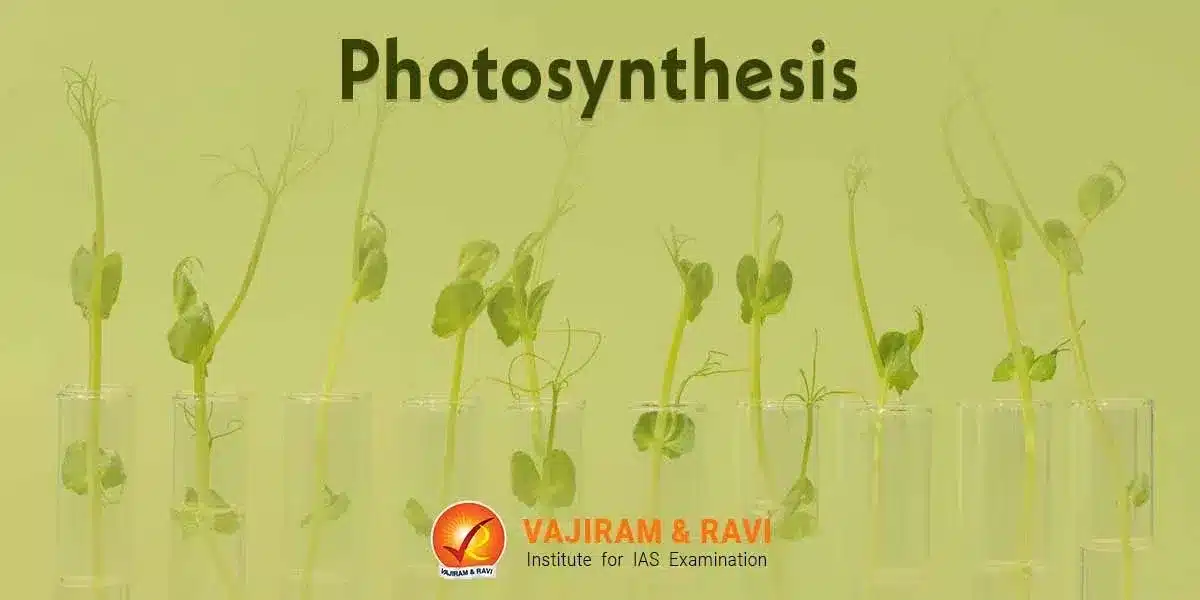Photosynthesis is the physicochemical process by which green plants, algae, and some bacteria synthesise organic compounds in the presence of sunlight using components such as carbon dioxide and water. In this process, light energy is converted to chemical energy in the form of sugars and Oxygen as a byproduct.
Photosynthesis by green plants and other photoautotrophs is the basis of life as it is the primary source of all food on Earth.
Where does Photosynthesis take place?
Photosynthesis takes place in the chloroplast organelle of plant cells. It is a double-membrane organelle having its own DNA, mitochondria, and ribosomes. It also contains a third inner membrane, called thylakoid.
- Thylakoid membranes: They look like stacks of coins. It contains chlorophyll.
- The membrane system is responsible for trapping the light energy for the synthesis of ATP and NADPH.
- Stroma: The space between the thylakoid and the chloroplast membranes is called the stroma.
- Within the stroma, enzymatic reactions occur to synthesize sugar, subsequently leading to the formation of starch.

Factors affecting Photosynthesis
Following are the components of the photosynthesis and their role:
- Sunlight: Photosynthesis relies on wavelength-specific light called Photosynthetically Active Radiation (PAR), which ranges from 400 to 700 nm (visible light).
- The wavelengths shorter than 400 nm or longer than 700 nm give a low CO2 assimilation yield.
- At the lower intensity, there is a linear relationship between incident light and CO2 fixation rates (Biomass conversion).
- An increase in incident light beyond a point can cause the breakdown of chlorophyll and a decrease in photosynthesis.
- Carbon dioxide (CO2): Carbon dioxide undergoes reduction to produce carbohydrates during photosynthesis.
- An optimal concentration of CO2, up to 0.05 per cent in the atmosphere, supports photosynthesis.
- Beyond this threshold, CO2 becomes detrimental to the photosynthetic process.
- Presently, the concentration of CO2 in the atmosphere is 0.04 per cent.
- Temperature: The chemical reactions involved in photosynthesis are performed by enzymes which are influenced by temperature.
- The temperature optimum for photosynthesis in various plants is also influenced by their adapted habitat. Tropical plants, for instance, have a higher temperature optimum compared to plants adapted to temperate climates.
- C4 plants exhibit increased photosynthesis rates in response to higher temperatures, unlike C3 plants. Hence, C4 plants are favoured in the tropical region.
- Water (H2O): In photosynthesis, water gets oxidised to produce oxygen.
- Thus, the oxygen released by the green plant originates from water, not from carbon dioxide.
- Water stress can lead to the closing of stomata thereby reducing the CO2 availability. It also reduces the surface area of the leaves and their metabolic activity.
- In anoxygenic photosynthesis, photoautotrophic bacteria utilise hydrogen sulfide (H2S) as an electron donor to produce sulfur or sulfate, depending on the organism, rather than O2.
- Pigments: Pigments are substances that absorb energy from blue and red sunlight waves (at specific wavelengths).
- Chlorophyll is present in the thylakoid membranes of chloroplast. It is responsible for the green colour in plants.
- Chlorophyll a is the major pigment, but there are various types of chlorophyll and also other pigments that respond to light, such as carotenoids and xanthophylls.
- The other pigments broaden the range of light and help in channelising it to chlorophyll a.
- They also have other functions such as protecting the cell from photo-damage.
- For example, dinoflagellates that cause the "red tides" to warn against eating the toxic shellfish, contain chlorophyll and red pigments.
- RuBisCO (Ribulose Bisphosphate Carboxylase-Oxygenase) Enzyme: This most abundant enzyme on the Earth is responsible for carbon fixation.
- Present in the chloroplast, it is capable of binding to both CO2 (Carboxylase) and O2 (Oxygenase) and can engage both in carbon fixation or photorespiration, depending on many factors.
Steps of Photosynthesis in Plants
Photosynthesis in plants occurs in chloroplast via two stages, namely Light-dependent reaction and Light-independent reaction.

Light-dependent Reaction
- Photosynthesis initiates with the light reaction, occurring in the presence of sunlight, within the thylakoid membranes.
- Light energy, captured by the pigments, energises the electrons which are then shunted to an electron transport chain (ETC).
- Through this ETC, ATP and NADPH molecules are produced during photo-phosphorylation.
- Simultaneously, a chlorophyll molecule replaces the lost electron, by splitting the water molecule to oxygen.
Light-independent Reaction
The dark reaction is a carbon-fixing and light-independent process, where sugar molecules are produced from water and carbon dioxide.
- Calvin cycle or Calvin-Benson cycle:
- This reaction takes place in stroma, utilising the NADPH and ATP produced in the light reaction.
- RuBisCO uses the carbon dioxide, absorbed by stomata, to produce a 3-carbon sugar, glyceraldehyde-3-phosphate, which is then used by the plants to make complex sugars (glucose, starch, cellulose).
- Most plants (85%), such as rice, wheat, soybean, etc. are C-3 plants.
- Rubisco's oxygenase property at high temperature or low CO2-O2 ratio initiates a photorespiration pathway which leads to the loss of already-fixed carbon.
- These constraints compelled plants to evolve the C4 cycle in which a four-carbon compound is produced to fix the CO2.
- Examples of C4 plants are maize, sugarcane, and sorghum, etc.
Other Versions of Photosynthesis
The Photosynthesis process is not limited to green plants but is also performed by various bacteria and algae.
Photosynthesis in Bacteria
Bacteria can perform both oxygenic and anoxygenic photosynthesis by using light-harvesting pigments.
- Oxygenic photosynthesis: Oxygenic photosynthetic bacteria absorb carbon dioxide and release oxygen. Cyanobacteria, commonly referred to as blue-green algae, exemplify this process.
- Anoxygenic photosynthesis: Some bacteria under anaerobic conditions, use H2S and other compounds as a reducing agent instead of water. Examples are green and purple sulphur bacteria and red and green Filamentous Anoxygenic Phototrophs (FAP), etc.
Photosynthesis in Algae
Almost all algae (dinoflagellates, diatoms, golden algae, brown algae, red algae and green algae) can perform photosynthesis.
- Photosynthesis and photorespiration in green algae closely resemble those in C3 higher plants. However, they have the ability to utilise bicarbonate as an inorganic carbon source, leading to a significant rise in intracellular CO2 concentration.
- This increase inhibits the oxygenase activity of Rubisco, suppressing photorespiration and increasing its photosynthetic efficiency.
- Photosynthetic efficiency of Algae is higher than in higher plants, also because of a wide range of light-harvesting pigments such as chlorophylls, phycobiliproteins, and carotenoids.
Artificial Photosynthesis
Bioreactors using various models can mimic the actual photosynthesis.
- Significance: It seeks to overcome the limitations of natural photosynthesis such as low efficiency in solar energy capturing and reduction of carbon dioxide.
- It can provide an alternative route of food security and climate mitigation.
- Methods: Several systems have been demonstrated to convert carbon dioxide and water into various reduced species - Carbon Monoxide, methanol, formate, and hydrogen.
- Research at JNCASR (India): Scientists at Jawaharlal Nehru Centre for Advanced Scientific Research have converted the carbon dioxide to carbon monoxide and water by using photosensitiser (ruthenium bipyridyl complex) and enzyme complex (rhenium carbonyl complex).
Significance of Photosynthesis
It is the bedrock of the existence of living beings as it has multiple ecological significance such as:
- Carbon cycle: Carbon compounds are interchanged among the biosphere and atmosphere of the earth through the process of Photosynthesis.
- Base for higher trophic levels: Green plants being autotrophs create a base for energy flow to higher trophic level heterotrophic organisms.
- Carbon fixation: Plants fix carbon from carbon dioxide into organic molecules through the process of photosynthesis.
- Oxygen: Oxygen is a byproduct of Photosynthesis which serves as an essential component of the Respiration process of living beings.
- Cyanobacteria and phytoplanktons in the oceans are considered to produce about one-third to one-half of the atmospheric oxygen on the Earth.
Last updated on December, 2025
→ Check out the latest UPSC Syllabus 2026 here.
→ Join Vajiram & Ravi’s Interview Guidance Programme for expert help to crack your final UPSC stage.
→ UPSC Mains Result 2025 is now out.
→ UPSC Notification 2026 is scheduled to be released on January 14, 2026.
→ UPSC Calendar 2026 is released on 15th May, 2025.
→ The UPSC Vacancy 2025 were released 1129, out of which 979 were for UPSC CSE and remaining 150 are for UPSC IFoS.
→ UPSC Prelims 2026 will be conducted on 24th May, 2026 & UPSC Mains 2026 will be conducted on 21st August 2026.
→ The UPSC Selection Process is of 3 stages-Prelims, Mains and Interview.
→ UPSC Result 2024 is released with latest UPSC Marksheet 2024. Check Now!
→ UPSC Prelims Result 2025 is out now for the CSE held on 25 May 2025.
→ UPSC Toppers List 2024 is released now. Shakti Dubey is UPSC AIR 1 2024 Topper.
→ UPSC Prelims Question Paper 2025 and Unofficial Prelims Answer Key 2025 are available now.
→ UPSC Mains Question Paper 2025 is out for Essay, GS 1, 2, 3 & GS 4.
→ UPSC Mains Indian Language Question Paper 2025 is now out.
→ UPSC Mains Optional Question Paper 2025 is now out.
→ Also check Best IAS Coaching in Delhi
Tags: photosynthesis quest

















